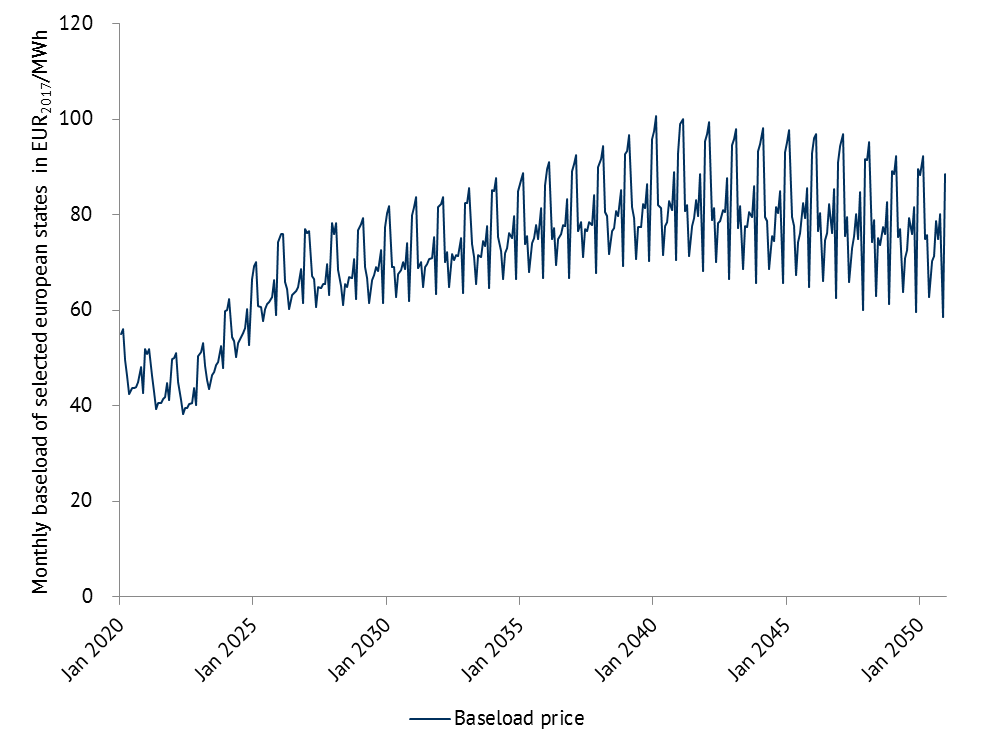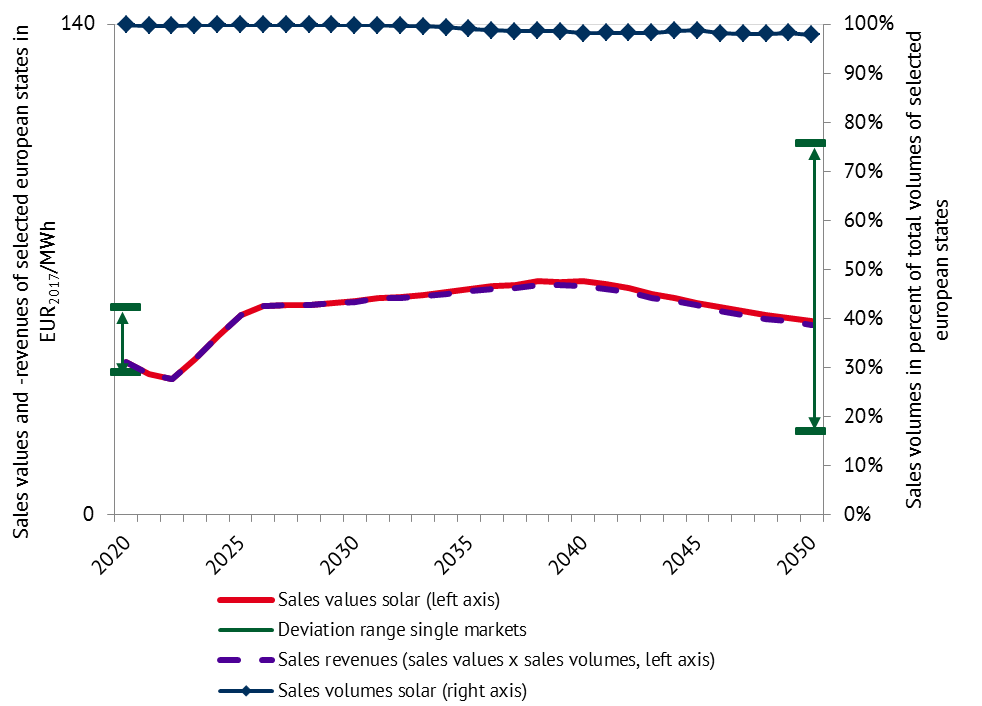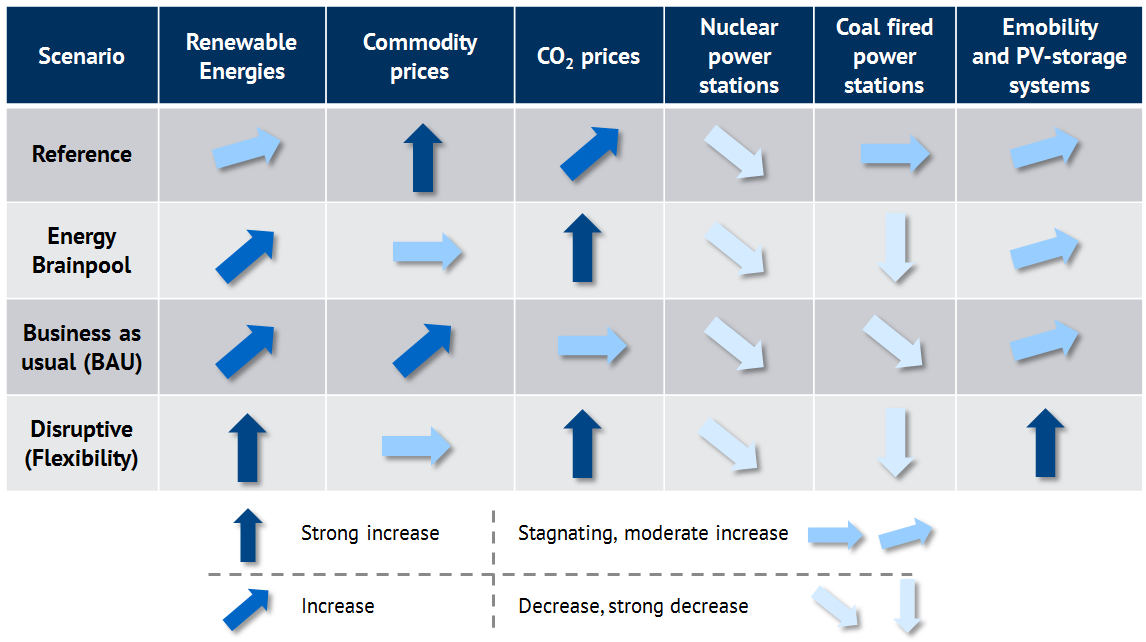With its current “EU Energy Outlook 2050”, Energy Brainpool shows long-term trends in Europe. The European energy system will change dramatically in the coming decades. Climate change and aging power plants are forcing the European Union and other countries to change their energy policies. What do these developments mean for electricity prices and revenue potential for photovoltaics and wind?
The electricity markets in Europe are subject to constant change, which makes current price scenarios inevitable. Only this way can, for example, market developments, assets and contracts, investment decisions or business models be correctly evaluated.
The “EU Energy Outlook 2050” shows the development of the “EnergyBrainpool” scenario for EU-28, Norway and Switzerland. The actual results in the individual countries can vary considerably. In order to make well-founded decisions, detailed modelling of the individual national markets and the influencing factors there, including sensitivity analyses, is essential.
What does the power plant fleet of the future look like?*
![Installed generation capacities in EU 28 (incl. NO and CH) by energy carrier; Source: Energy Brainpool, "Energy, transport and GHG emissions Trends to 2050 - Reference Scenario 2016" “ [1] , “TYNDP 2018” [4 Installed generation capacities in EU 28 (incl. NO and CH) by energy carrier; Source: Energy Brainpool, "Energy, transport and GHG emissions Trends to 2050 - Reference Scenario 2016" “ [1] , “TYNDP 2018” [4](https://blog.energybrainpool.com/wp-content/uploads/2019/01/Bild1-3.png)
Figure 1: Installed generation capacities in EU 28 (incl. NO and CH) by energy carrier; Source: Energy Brainpool, “Energy, transport and GHG emissions Trends to 2050 – Reference Scenario 2016” “ [1] , “TYNDP 2018” [4]
To limit climate change, replacement technologies with low emissions are needed – a renaissance of coal is therefore out of the question. Well-known and proven technologies are available for the future: Gas-fired power plants, renewable energies and nuclear power plants.
Wind power and photovoltaics in particular continue to have great growth potential. These technologies are now competitive – thanks to the sharp drop in costs over the past ten years. Experts expect this development to continue. In the “EU Energy Outlook 2050”, the share of these variable renewable energy sources (vRES) will rise to almost 50 percent of the total supply by 2050.
At the European level, gas-fired power plants in particular will be added to steerable fossil generation capacities in the future. This is due to the lower emissions compared to coal-fired power plants. Even with carbon capture storage (CCS), the latter will continue to lose importance.
The capacities of nuclear and coal-fired power plants will be reduced by more than 55 percent by 2050. Germany, France, Great Britain, Spain, the Netherlands and Belgium have announced coal phase-outs for the future. As a result, the currently installed capacity of hard coal in particular will fall sharply to around 55 percent by 2030.
Overall, the share of generation capacity from steerable, thermal power plants will be reduced from 50 percent to around 30 percent by 2050. This will have a considerable impact on the structure of power prices, which are increasingly influenced by vRES.
Why does electricity demand rise until 2050?
![Gross electricity generation of generating technologies and gross electricity demand in EU 28 (incl. NO and CH); Source: Energy Brainpool, "Energy, transport and GHG emissions Trends to 2050 - Reference Scenario 2016" “ [1] , “TYNDP 2018” [4] Gross electricity generation of generating technologies and gross electricity demand in EU 28 (incl. NO and CH); Source: Energy Brainpool, "Energy, transport and GHG emissions Trends to 2050 - Reference Scenario 2016" “ [1] , “TYNDP 2018” [4]](https://blog.energybrainpool.com/wp-content/uploads/2019/01/Bild2-1.png)
Figure 2: Gross electricity generation of generating technologies and gross electricity demand in EU 28 (incl. NO and CH); Source: Energy Brainpool, “Energy, transport and GHG emissions Trends to 2050 – Reference Scenario 2016” “ [1] , “TYNDP 2018” [4]
The amount of electricity produced from coal-fired power plants is declining sharply, falling by around 60 percent by 2030 and by around 95 percent by 2050. However, production from gas-fired power plants will increase by around 40 percent by 2050. Wind and solar power plants will generate around 44 percent of the electricity in 2050. Around 36 percent of the electricity comes from steerable fossil power plants. The remaining electricity is produced by steerable, renewable energies such as biomass power plants or reservoirs.
Demand for electricity will rise by around 17 percent by 2050. Above all, population growth and more electrification in households will increase the demand for electricity. According to the plans of the European Commission, most of the economic growth will take place in the tertiary service sector, which also needs more electricity.
In the industrial sector, increased efficiency can prevent a significant increase in electricity consumption. This scenario conservatively assesses how the coupling of the electricity, heat and transport sectors will develop. In passenger transport, hybrid cars will reduce the consumption of commodities. At the same time, emissions in the heating sector will decrease due to increased efficiency and lower consumption of coal and oil.
The long-term development of commodity prices

Figure 3: Commodity prices, Source: World Energy Outlook 2018 (“Sustainable Development”) and own calculations Energy Brainpool
The development of the most important commodities until 2040 is based on the “Sustainable Development” scenario of the IEA’s World Energy Outlook 2018 [2]. In this scenario, three goals are defined:
- The stabilisation of climate change, clean air and universal access to modern energy [3]. In this scenario, prices for CO2 certificates rise significantly.
- The prices for gas, oil and hard coal remain at a rather constant level.
- The development from 2040 to 2050 is an extrapolation.
The development of average electricity prices
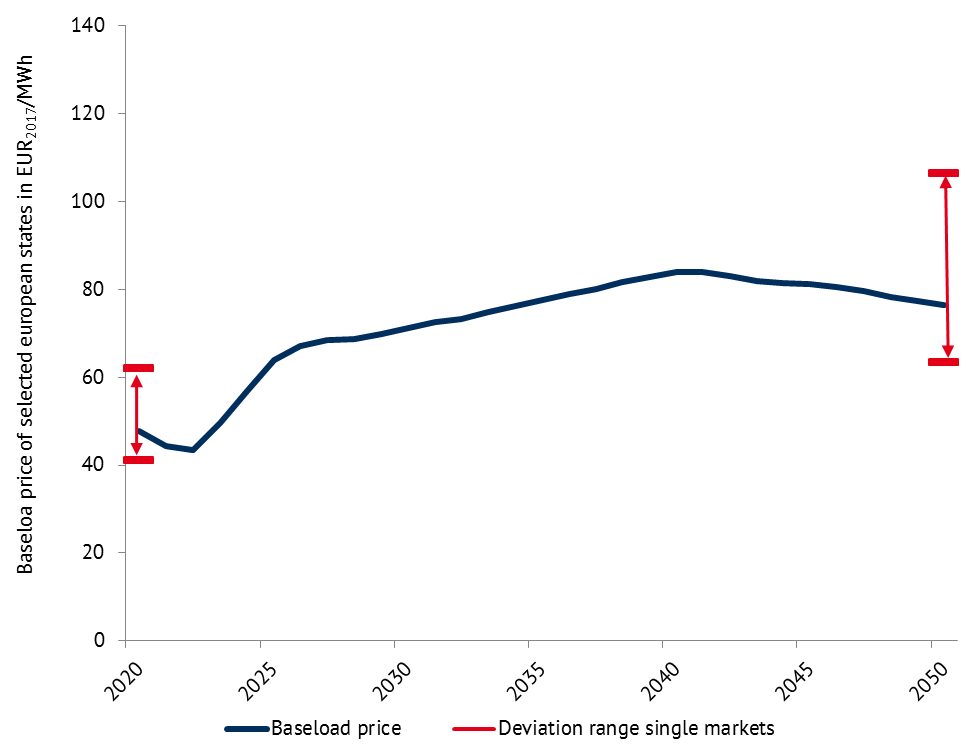
Figure 4: Annual baseload prices and the range of deviations of national markets of selected countries in Europe on average, Source: Energy Brainpool
Primary energy and CO2 prices are the most relevant factors for the development of average, unweighted electricity prices between 2020 and 2040. From 2040, electricity prices will stagnate and even fall slightly despite rising gas and CO2 prices. The reason: High feed-in from wind and photovoltaic power plants will increasingly lead to low and more often negative electricity prices.
The actual developments in the individual countries differ, in some cases very significantly, from one another. This is shown by the deviation ranges shown. In particular, countries with little expansion of renewable energies are recording a steady rise in electricity prices (due to the development of commodity prices).
If we look at power prices on a monthly basis, we can see the seasonality and volatility of the power market. For the winter, the analyses show rising prices due to the temperature sensitivity of electricity demand.
On the other hand, electricity prices are usually significantly lower in the summer. This effect is reinforced by the increasing share of solar power generation, which has a price-reducing effect.
What revenues can wind turbines achieve?
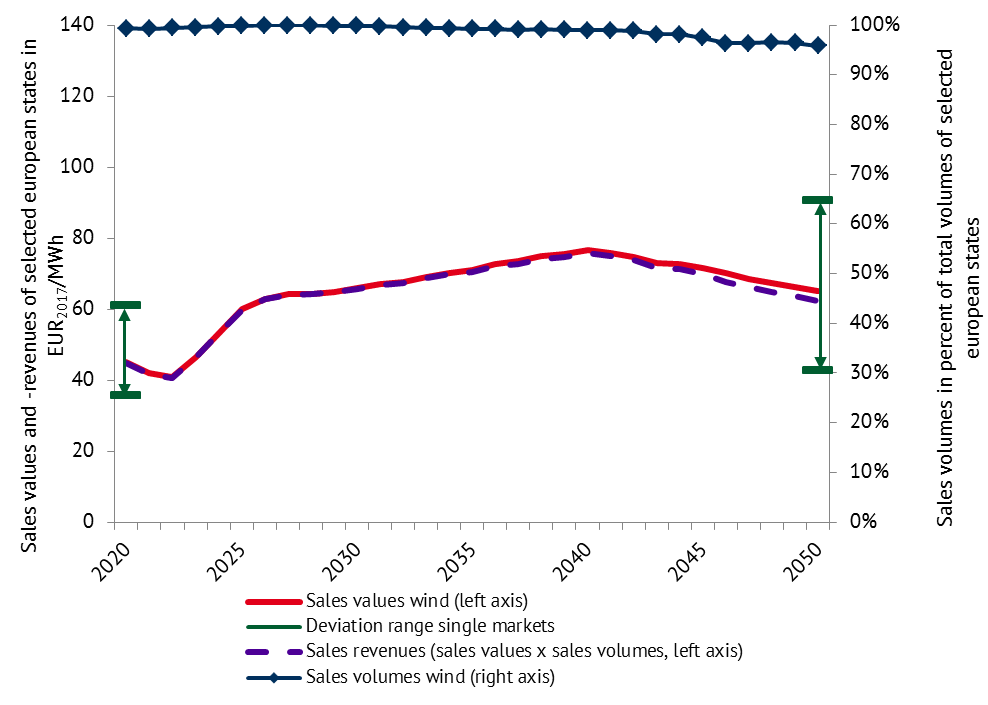
Figure 6: Average sales values and volumes of wind in selected EU countries, Source: Energy Brainpool
The sales value is the average volume-weighted power price that wind power plants can achieve on the spot market. Only generation hours with positive electricity prices are taken into account (including 0 EUR/MWh). Until 2040, the sales value of wind energy will rise and then fall slightly – due to further increases in capacity.
Parallel generation reduces power prices in these hours (merit order effect). The sales volumes (share of generated volumes at electricity prices >=0 EUR/MWh) will decline only slightly on average in the EU, and in some countries will also decline very significantly. Sales revenues result from the product of sales values and sales volumes.
Given the many hours during which prices are set by steerable fossil-fuel power plants despite the high share of renewable energies, rising positive revenue streams are possible. The fluctuation range of the markets shows how different the country-specific average revenue opportunities of wind turbines are.
Energy Brainpool defined, among other things, the indices sales value and volume in the white paper “Valuation of electricity market revenues of fluctuating renewable energies“. These indices enable a realistic determination of the revenue potential of fluctuating, renewable energies in the electricity market.
What revenues can photovoltaic systems (solar) achieve?
The development of sales values for solar energy is in line with the trend for sales values for wind energy, but at a lower level. The reason for this is the significant simultaneity effect of solar energy: the majority of electricity is generated during the day in summer. In hours when a lot of solar power is generated, the price of electricity and thus the revenues fall.
The sales volumes for solar energy are also declining only slightly on average in the EU, but very significantly in specific countries. The large fluctuation margin of the solar sales values in the individual countries shows how strongly the revenue opportunities vary. Here, however, it should be noted that in a sunny country high revenues are possible even with low sales values. The reason for this is that the plants are operating at better utilization rates.
Solar thermal plants for electricity generation are a marginal technology in the scenario and are not being expanded on a large scale.
Increase in price volatility in detail
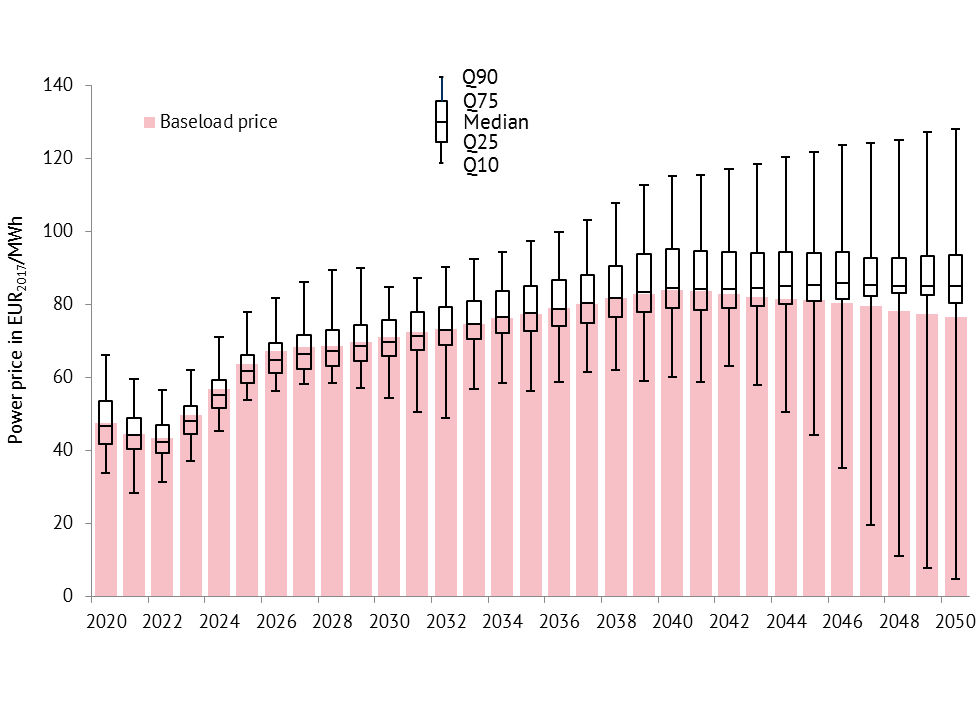
Figure 8: Number of positive and negative extreme prices on average in selected EU countries, Source: Energy Brainpool
In the scenario, many factors lead to a significant increase in price volatility. On the one hand, the generation costs of steerable fossil-fuel power plants are rising due to the development of commodity prices. On the other hand, the expansion of fluctuating renewable energies has a price-reducing effect. As a result, extreme prices occur much more frequently from today’s perspective and become a normal part of the electricity price structure of the day-ahead market.
National capacity-specific revenues from fluctuating renewable energies
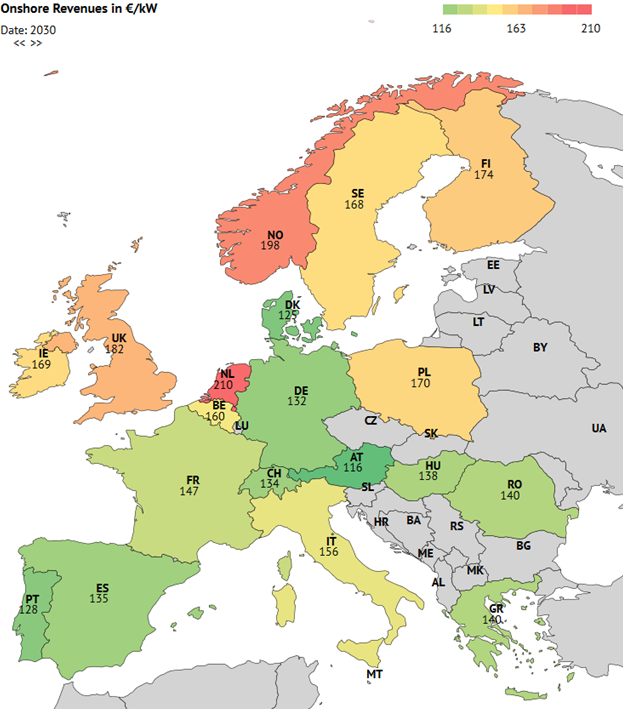
Figure 9: National capacity-specific revenues onshore in 2030 in EUR2017/kWnat of chosen European states, Source: Energy Brainpool

Figure 10: National capacity-specific revenues solar in 2030 in EUR2017/kWp,nat of chosen European states, Source: Energy Brainpool
At which locations and countries or in which technology should investments be made? On the one hand, the average revenues of fluctuating renewable energies must be taken into account by means of the sales value in EUR/MWh and, on the other hand, the annual energy output of the respective technology and location must also be taken into account.
This is made possible by the capacity-specific revenue. It represents the respective average revenues per installed kW. By looking at the average sales values in EUR/MWh it seems like that a PV system in Spain generates less revenues than a PV system located in the UK. However, this is put into perspective by the high capacity utilisation and thus full load hours in Spain, so that the system ultimately generates more revenue per kW than in the UK. Such a parameter can, of course, also be determined for a specific location.
The results show that wind turbines are more likely to generate higher revenues in Northern European countries, while solar systems are more likely to have a revenue advantage in Southern European countries.
Fluctuations due to different scenario assumptions
Energy Brainpool offers a variety of different scenarios. Figure 11 shows the different trends of the scenarios. The fluctuations relate both to the assumptions on the development of commodity prices, the power plant fleet, e-mobility and other flexibility options.
Figure 12 shows the corresponding results of the electricity prices of the respective scenarios.
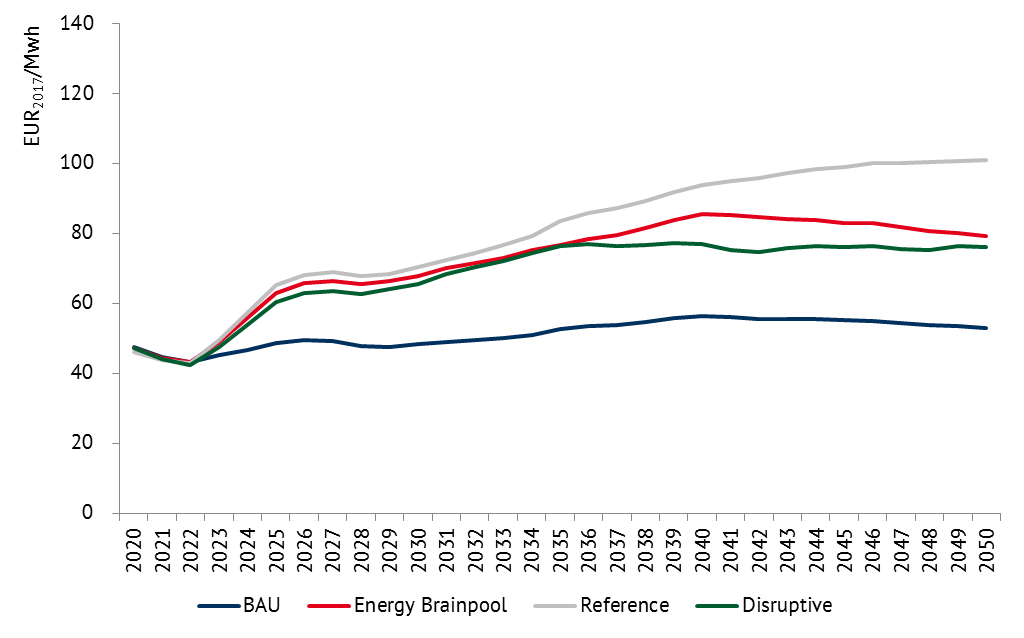
Figure 12: Development of power prices in EUR2017/MWh of the respective scenarios of selected EU states, source: Energy Brainpool
* EU-28 incl. Norway and Switzerland, depending on the evaluation, only the most significant states were selected to determine the mean.
Read more about the first issue of EU Energy Outlook here.
[1] https://ec.europa.eu/energy/sites/ener/files/documents/ref2016_report_final-web.pdf
[2] https://www.iea.org/weo2017/



